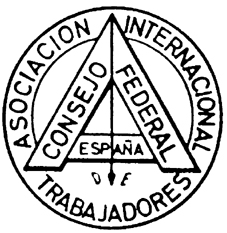Still working to recover. Please don't edit quite yet.
â’¶
The Circle-A is almost certainly the best-known present-day symbol for anarchy. It is a monogram that consists of the capital letter "A" surrounded by the capital letter "O". The letter "A" is derived from the first letter of "anarchy" or "anarchism" in most European languages and is the same in both Latin and Cyrillic scripts. The "O" stands for order. Together they stand for "Anarchy is Order" the first part of a Proudhon quote.[1]
This character can be written as Unicode codepoint U+24B6 (Ⓐ). In addition, the "@" sign or "(A)" can be used to quickly represent the circle-A on a computer.
Pre-Anarchist usage[edit]
An early occasion when the encircled A was used was in Stephan Michelspacher book Spiegel der Kunst und Natur (Mirror of Art and Nature) which was published in Augsburg 1615. This was an Alchemical work strongly influenced by Agrippa's view of the Kabbalah and magic. Adam McLean describes the centre panel as "two circular diagrams with the German GOTT (the name of God) around the outside, and also the Alpha and Omega @ and the monograph which may be the name of God, Agla.[1] This represents the beginning - alpha - within the end - omega (the first and last letters of the Greek alphabet. This relates to the claim related in the Book of Revelation that Jesus was "the "Alpha and Omega, the beginning and the end, the first and the last" (22.13). Many Anarchists have been Freemasons, and rosicrucian imagery of this type was used by the Golden Dawn. The Anarchist (and police spy) Theodor Reuss was associated with William Wynn Westcott, one of the founders of the Golden Dawn, before setting up the Ordo Templi Orientis. Two offshoots of this - Ancient Mystical Order Rosae Crucis and Aleister Crowley's Thelema used the formulation "Do what thou wilt shall be the whole of the Law", which many have taken up as an anarchist slogan.
History of Anarchist usage[edit]
The first recorded use of the A in a circle by anarchists was by the Federal Council of Spain of the International Workingmen's Association. This was set up by the freemason[2], Giuseppe Fanelli in 1868. It predates its adoption by anarchists as it was used as a symbol by freemasons amongst others.
It was later used in the Spanish Civil War,(1936–1939). There is a picture of an anarchist militia member with the circle-A painted clearly on the back of his helmet. It was adopted as a symbol of the Alliance Ouvrière Anarchiste (AOA) as its symbol at its 25 November 1956 founding in Brussels, and appears to have been independently reinvented in 1964 by the French group, Jeunesse Libertaire ("Libertarian Youth"). [3]
Obviously, the circle-A long predates the anarcho-punk movement, which was part of the punk rock movement of the late 1970s. However, the punk movement certainly spread the circle-A anarchy symbol more widely, even among non-anarchists.
Anarcho-punk modifications[edit]
Frequently, the artist drawing the symbol will add a number of embellishments in order to further symbolize the ideals of anarchism. Almost always, the symbol is drawn by hand without the aid of straightedges, so as not to be overly neat. As anarchism is a rejection of the pre-existing order, the anarchy symbol thus distances itself from other symbols that are traditionally drawn neatly (e.g., currency symbols).
The "A" is frequently rendered with its horizontal line extending beyond the two diagonals, and often skewed off of the horizontal. The letter is typically scaled so that the majority of the five points of the "A" lie outside the circle, although the center of the letter remains inside. Namely, the five points are (1) the intersection of the two diagonals; (2) and (3) the other ends of the two diagonals; (4) and (5) the ends of the horizonal line.
The result of this particular typical embellishment, intentionally or not, is a similarity to the pentagram, which some Christians frequently associated with satanism. Ironically, both the pentagram and the anarchy symbol are primarily used to symbolize ideas and ideals that have nothing to do with satanism. Despite this fact, the pentagram and (to a lesser degree) the anarchy symbol are associated with satanism by many Westerners.
Occasionally, the symbol will be made to look like it was drawn in flame or blood splatters. Even if this embellishment is not used, red on a black background is a popular color choice since these colors have been associated with the anarchist movement for over a century (see anarcho-syndicalism and compare with the anarcho-syndicalist red-and-black flag).
These last few design choices may be due to the possibly unfounded association of anarchy with satanism — many who draw the anarchy symbol are using it simply as a symbol of rebellion against authority. The Western world has historically been under the authority of Christianity. It is natural, therefore, for rebellious youth to seek out what they view as the antithesis of authority, which in Christianity's case is Satanism. Lucifer's Fall from grace depicts images of rebellion against the authority of God, a stance demonstrating a parallel between Satanism and anarchism.
The anarcho-punk movement embraces the heavily stylized circle-A. More traditional, political anarchists do not add so many embellishments, or they don't use this symbol at all. Some anarchists feel that the symbol has been commercialized by a few artists wishing to sell albums, caring little for the benefits of anarchy as a system of non-government. While it can't be taken as absolute fact, some anarcho-punks note that more punks and punk bands that actually are anarchists use the traditional circle-A, rather than the stylized one, which is used much more often by those who do not have much knowledge of anarchism.
As a result of its draw as a symbol of rebellion and of the anarcho-punk movement, the anarchy symbol is frequently seen drawn or spray-painted on walls as graffiti.



